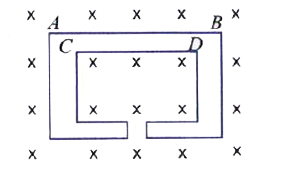Read the assertion and reason carefully to mark the correct option
Assertion: When the length of a conductor is doubled, its resistance will also get doubled.
Reason: Resistance is directly proportional to the length of a conductor.
If both assertion and reason are true and reason is the correct explanation of assertion.
If both assertion and reason are true but reason is not the correct explanation of assertion.
If assertion is true but reason is false.
If assertion and reason both are false.
To solve the question, we need to analyze both the assertion and the reason provided.
1. Understanding the Assertion:
- The assertion states: "When the length of a conductor is doubled, its resistance will also get doubled."
- This implies that if we take a conductor and increase its length by a factor of 2, the resistance of that conductor will also increase by a factor of 2.
2. Understanding the Reason:
- The reason states: "Resistance is directly proportional to the length of a conductor."
- This means that if the length of the conductor increases, the resistance will increase as well, which aligns with the assertion.
3. Resistance Formula:
- The resistance R of a conductor can be expressed by the formula:
R=ρLA
- Where:
- R = resistance
- ρ = resistivity of the material (a constant for a given material)
- L = length of the conductor
- A = cross-sectional area of the conductor
4. Effect of Doubling Length:
- If we double the length L (i.e., L′=2L), the new resistance R′ can be calculated as:
R′=ρ(2L)A=2⋅ρLA=2R
- This shows that the resistance indeed doubles when the length of the conductor is doubled.
5. Conclusion:
- Since both the assertion and the reason are correct and the reason correctly explains the assertion, we conclude that the correct option is the one that states both the assertion and the reason are correct.
Final Answer:
- Both the assertion and the reason are correct, and the reason correctly explains the assertion.
---
- The assertion states: "When the length of a conductor is doubled, its resistance will also get doubled."
- This implies that if we take a conductor and increase its length by a factor of 2, the resistance of that conductor will also increase by a factor of 2.
- The reason states: "Resistance is directly proportional to the length of a conductor."
- This means that if the length of the conductor increases, the resistance will increase as well, which aligns with the assertion.
- The resistance R of a conductor can be expressed by the formula:
R=ρLA
- Where:
- R = resistance
- ρ = resistivity of the material (a constant for a given material)
- L = length of the conductor
- A = cross-sectional area of the conductor
- If we double the length L (i.e., L′=2L), the new resistance R′ can be calculated as:
R′=ρ(2L)A=2⋅ρLA=2R
- This shows that the resistance indeed doubles when the length of the conductor is doubled.
- Since both the assertion and the reason are correct and the reason correctly explains the assertion, we conclude that the correct option is the one that states both the assertion and the reason are correct.
- Both the assertion and the reason are correct, and the reason correctly explains the assertion.
Topper's Solved these Questions
- CURRENT ELECTRICITYBOOK - CENGAGE PHYSICSCHAPTER - CURRENT ELECTRICITYEXERCISE - CHALLENGING EXERCISE
2 Videos
- ATOMIC AND NUCLEAR PHYSICS BOOK - CENGAGE PHYSICSCHAPTER - ATOMIC AND NUCLEAR PHYSICS EXERCISE - OLYMPIAD AND NTSE LEVEL EXERCISES
8 Videos
- ELECTROMAGNETIC INDUCTION BOOK - CENGAGE PHYSICSCHAPTER - ELECTROMAGNETIC INDUCTION EXERCISE - OLYMPIAD AND NTSE LEVEL EXERCISES
10 Videos
Similar Questions
A 2 V cell is connected to a 1 ohm resistance. How many electrons come out of the negative terminal of the cell in 2 minutes?
View SolutionMark the correct statement
View SolutionA wire is bent to form the double loop shown in figure. There is a uniform magnetic field directed into the plane of the loop. If the magnitude of this field is decreasing, current will flow from:

View SolutionAssertion : When the length of a conductor is doubled, its resistance will also get doulbed. Reason : Resistance is direclty proportional to the length of a conductor.
View SolutionAssertion: When the radius of a copper wire is doubled, its specific resistance gets increased.
Reason: Specific resistance is independent of cross-section of material used
View Solutionसिद्ध कीजिए कि किसी चालक का प्रतिरोध उसकी ( लम्बाई / अनुप्रस्थ - काट के क्षेत्रफल ) के अनुक्रमानुपाती होता है ।
View Solutionयदि चालक तार की लम्बाई दुगुनी कर दी जाए तो प्रतिरोध पर क्या प्रभाव होगा?
View Solutionकिसी चालक का प्रतिरोध उसकी लम्बाई के व्युत्क्रमानुपाती होता है ।
View Solutionकिसी चालक तार की लम्बाई को खींचकर दुगुना लम्बा कर दिया जाता है। उसका प्रतिरोध कितना गुना हो जाएगा?
View SolutionWhen the diamter of a conductor is doubled its resistance _______
View SolutionThe resistance of a conductor directly proportional to ____________.
View SolutionThe resistance of a conductor directly proportional to ____________.
View SolutionThe resistance of a conductor is inversely proportional to its_____________.
View SolutionWhat happens to resistance of the conductor when length is doubled
View SolutionAssertion (A): When the radius of a copper wire is doubled, its specific resistance gets increased Reason ( R): specific resistance is independent of cross-section of material used
View Solutionஒரு கடத்தியின் மின்தடை இதற்கு நேர்விகிதத்தில் இருக்கும்
View Solution

